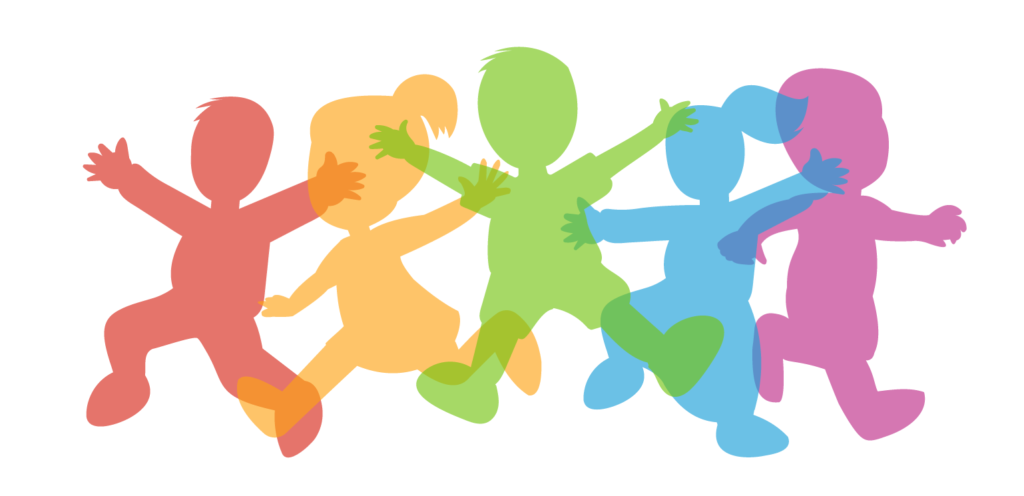Bulles aux éclats – English translations
Introduction – « Bulles aux éclats »
Throughout the summer, BDFIL celebrates comics by exploring humour. From June 17 to September 21, 2024, you’ll discover the many facets of humour in comics. As you stroll through the city, from the Cathedral to the lakeside, you’ll learn more about the codes of laughter and gags. This exhibition is also an opportunity to explore the socio-political aspects of humour. It particularly shows the power of humour in confronting politics, and how it can be used to denounce sexist stereotypes and fight for emancipation. Sometimes serious, sometimes mischievous, the exhibition promises many surprises. This outdoor exhibition is a walk in ten chapters, each covering a specific theme to reflect on humour through comics, and vice versa.
Chapter 1 – About Laughter in Comic Strips
The Faces of Laughter
To represent characters who are laughing, comic strips distort their faces. The drawing can be very simplified, with a wide-open mouth and a simple line for the eyes, such as in the drawings of Franquin, Ulli Lust and Boucquet; or it can be much more realistic, as in Il était 2 fois Arthur by Nine Antico and Grégoire Carlé. In any case, a speech bubble with a few letters – “Ha Ha Ha Ha” – is an easy way to convey that the characters are bursting into laughter; sometimes, as in wide framings, it is enough.

It’s always pleasant to see people laugh; it’s even said that it makes us want to laugh too. Is that the case for you?
From Laughter to Tears
Moving from one panel to the next, from one board to the next, enables to switch very quickly from laughter to tears in a comic strip. In Habibi, Craig Thompson depicts a slightly mad character who tries to save those who can be saved in streets consumed by ruin and poverty. His optimism drives him to laugh in the worst situations, but he ends up weeping when one of his protégés dies.
Conversely, in Les Belles personnes, Chloé Cruchaudet shows how a young boy suffering from a behavioural disorder switches abruptly from panic and tears as a storm breaks out to the enthusiasm of laughter thanks to the solidarity of the teenagers who surround him. Comic strips need no explanation to narrate this abrupt change, just a few juxtaposed images.

From one panel to the next, the characters laugh and then cry! Have you already felt like laughing just after crying a lot?
The Origin of Laughter
To a large extent, comic strips are an art of laughter; unlike in French, in English we talk about comics and funnies. They feature scenes in which the readers laugh as they look at the drawings, as in this panel of Élise et les nouveaux partisans where the editorial team of a comic strip newspaper laughs as they look at the drawings (we can recognise in particular press cartoonists from Charlie Hebdo, Gébé on the left and Reiser on the right).
They can also more broadly depict the comical art from which they take inspiration, such as scenes from Alice Guy’s burlesque silent films.
When comedians tell the story of their life, they sometimes try to understand where their love of laughter comes from. Thus, Florence Dupré la Tour recalls her early childhood and the moment when, still a baby, she learnt to make her twin sister laugh, to explain where the art of making people laugh came from.

We laugh a lot when we watch films or read comic books. This is often how children decide to become comic strip illustrators. However, Florence Dupré la Tour explains that her vocation came when she was still a baby and wanted to make her twin sister laugh!
Chapter 2 – Gags and the Body in Motion
Gags and the Body in Motion
In comic strips, gags rest on a character’s body being swept up by an uncontrolled movement ending with an abrupt stop. Laughter is unleashed by the choc, a brutal reminder of material reality. This kind of gag can be found as early as the first forms of comic strips, in the 19th century.
Funnies, comic strips published in the major daily newspapers in the United States from the beginning of the 20th century, entrenched the process: the body swept up by an uncontrolled movement disrupts daily life and shatters society.
The strip format enables the multiplication of very short gags, across three or four panels, to give readers of newspapers – in this case L’Humanité –a punchline, a small choc, a small jolt, to distract them from daily news every day.

Comic strips show people falling in full run or receiving big blows. It shouldn’t be funny because we can hurt ourselves when we fall, but it does make us laugh because it creates chaos all around!
Ill-treated Bodies
By being repeatedly tossed around every which way, the bodies of comic strip characters regularly end up in pretty bad shape.
It’s a running joke in the series Cavaliers de l’apocadispe: three kids keep engaging in very risky behaviours that cause accidents; their bodies (or those of their victims) suffer from every conceivable distortion, while remaining alive and continuing to move around…
With the many large, supple movements of its tail, Marsupilami submits ridiculous characters to all kinds of mishaps, as if it was punishing them: German illustrator Flix, who has recently taken over the drawing of the character, has succeeded in giving it a second life by turning it into a persistent perpetrator of gags.
In contemporary comic strips, these gags about falls can also affect adult characters, infusing a bit of madness in the world. They give a frantic pace to the life of Fun Girl, Elizabeth Pich’s wacky character. Like a clown, she keeps disrupting the surrounding society.

Les Cavaliers de l’apocadispe are always getting up to mischief and end up broken in pieces. Perhaps you have read their adventures in Spirou?
When Artists Poke Fun at Comic Strip Gags
The formula of punchline and blow gag is efficient and has been much repeated. It quickly became a stereotype of which comic strip illustrators often make fun. In his first comic strip, Gotlib thus emphasised the logic of the gag by multiplying falls to the point of absurdity; Boulet provides an exaggerated version of it, as though writing gags was an addictive practice that artists should watch out for or even cure themselves of!

It’s not always easy to draw comic strips; every day, artists must find a new gag! Do you think you could invent funny gags in your everyday life?
Gags in the Text
While we laugh a lot at the body in motion in comic strips, we can also laugh at the almost or totally motionless body. Laughter then comes from the repetition of the same image in which only the text underlines a change. The process has been much used by illustrators who wanted to make conversations and contradictions stand out. Bretécher’s social satires use this process a lot; the intellectuals that she represents are often sprawled on a couch, and their conversation reveals their privileges and political contradictions. We also see it in Fabcaro’s motionless strips as he draws characters in banal daily situations, yet with completely random statements.
Sophie Guerrive uses the same process while depicting animals, so that here, it’s the discrepancies between Tulipe the bear and Crocus the snake and their quirky dialogues that make us laugh.
Finally, L’Ami inintéressant takes the process one step further by depicting small wire figures that are almost motionless: the gag is then entirely conveyed in the text bubbles.

In these comic strips, the characters don’t move at all, but their dialogues make us laugh all the same: it’s the speech bubbles that bring movement!
Image Repetition
The stillness of bodies can be pushed to the limit: illustrators then purely and simply repeat the same image, without changing anything. It’s a process invented by Lewis Trondheim and Jean-Christophe Menu: in Moins d’un quart de seconde pour vivre, they represent a character sitting on a rock and reproduce the same panel several times, simply changing the dialogues.
Étienne Lécroart turns this into a clever game: he shows how comic strips can be built from repeated images, only differentiated by the dialogue.
As for Nicolas Wild and Lisa Mandel, they see there an opportunity for self-mockery: always repeating the same image is the opportunity for illustrators to not tire themselves over much and watch an episode of a series on their tablet. The rare details that are modified become absurd when the two characters sitting next to her on the train see themselves decked out with trunks.

Did you notice that the comic strips on this board always repeat the same panel? It’s not that the artists are lazy, it’s rather than it allows them to play with words or with details in the illustration.
Actual Sloths
To play with stillness in an even more realistic way, Sergio Salma and Marco Paulo rely on animals that practically don’t move: sloths. In this way, they can represent panels that are almost always identical and make jokes about how quickly or slowly time passes by.

Do you know about sloths, those animals that move very slowly? Illustrators make them speak like humans that see time fly by!
Chapter 3 – Serious Laughter
Laughing About the Ravages of Addiction
Laughter can be light and yet address very serious topics. Comic strip artists have for example laughed a lot about the various forms of addition. It’s often the subject of Reiser’s drawings, who himself experienced a difficult childhood in a very modest social background; he represents the relationship between an alcoholic father and his young son. The gags reveal cruel scenes in which the child is always the loser.
As for Émilie Gleason, she develops a representation of addiction to junk food in a meticulously researched album. She does so humorously, using ridiculous, exaggerated drawings and vibrant colours, depicting an interview given by a scientist on YouTube and transforming a medical handbook into a Bible. However, despite that humour, she constantly retains a medical point of view based on reliable sources and particularly painful testimonies. In this way, laughter sends a meaningful message.

Alcohol and food are very important topics. They are discussed with humour, but it helps people see that they need to be careful!
Social Satire
Illustrated social satire is generally represented as small daily skits in which the characters’ contradictions erupt: the one who criticises the reduction in working time makes the most of it to take time off (RTT = réduction du temps de travail, i.e. reduction in working time) and those who want to demonstrate protest against strikers who stop them from doing so… The characters are, of course, strongly caricatured both in their physical aspect and their behaviour, but the targeted social biases are very real.
Jean-Paul Krassinsky integrates this satire in the short stories he tells in Les Fables de la Poubelle. The caricature unfolds across the whole duration of a book fair, in which the authors are revealed as being quite hypocritical!

People often do the opposite of what they say. It’s always funny to see them turn around!
Humorous Journalism
The trend of reviews of topical comics has very significantly developed “comics journalism”. Most of these comic strips have a very serious tone, but it is nevertheless possible to find some that combine serious content with a humorous tone. Most often, the text in these comic strips offers a continuous, very well-researched commentary. On the other hand, the illustrations use irony, multiplying bizarre details, such as vets for monkeys or elephants who look like the animals they care for, or the death of a giraffe transformed into an episode of a romantic film. These comic strips keep playing on the discrepancies between the historical and social documentation and schoolboy humour.

It’s possible to do very serious documentaries, for example about illnesses, while joking. It’s not because we work a lot that we must stop laughing!
Chapter 4 – Laughter and Politics
Political Satire
To laugh about a man or woman of power sometimes amounts to attacking and caricaturing a real person. Most often, satirical illustrators use political cartooning in the format of a single drawing, but they also sometimes incorporate their victim in a short comic strip. They then use all the means at their disposal, from the physical caricature to the moral denunciation. Nowadays, these strips are often published online and on social media, such as the satire that Tiphaine Decointet regularly dedicates to news about French president Emmanuel Macron on the Instagram account Mâtin, Quel Journal! or the column that Loïc Sécheresse publishes in the online newspaper Les Jours.

Even famous men and women of power can end up being ridiculous when they get angry. Comic strips love to portray them in amusing situations.
Laughing About the Powerful
Sometimes, even if the political figure is recognisable, it is slightly transformed to create a fictional character who is more universal. In Quai d’Orsay, Taillard de Vorms reminds us strongly of French Minister for Foreign Affairs, Dominique de Villepin. However, the detour through fiction enables to depict both the greatness of the character, who is always in motion, and his ongoing inconsistencies. He subtly reveals the corridors of power.
This transformation can be such that we no longer recognise a given political figure. The “hero” in Charles Charles, profession président (Charles Charles, Profession President) presents all the features that characterise the political man or woman: uneducated, dumb, pretentious, misogynist. He could remind us of many political men and women, in Europe and America.

By repeatedly behaving in a nasty and idiotic manner, Charles Charles ends up being punished. The joke’s on him!
The Essence of Power
By giving a universal dimension to their criticisms, artists target the essence of power. Willem retraces the stereotypical journey of the harassed child who fights to “go far” and, once at the top, falls from a great height. The punchline of the board gives a blistering answer to the question, “Does power drive mad?”
In the strips of the Baron noir, Pétillon and Got represent a black eagle that collects every day its tribute of sheep in a flock thrown into confusion. This allegory of power enables them to represent the eternal relationship of domination on which our societies are built, as well as to allude to current issues, such as the relationship between power and unions, the role of the police, etc.

The Black Baron is an eagle who keeps capturing sheep. The sheep try everything to escape, yet the eagle always wins; it’s sad, but the repetition is also amusing!
Chapter 5 – Laughter and Women
Sexist Jokes
Like many forms of humour, funny comic strips have used misogynist stereotypes to build jokes. Not necessarily a very commendable technique, but we need to remember that for many years, even in very good comic strips, laughter was based on worn-out clichés, such as the idea that women don’t know how to drive.

Of course, women drive just as well as men, but for many years, there have been jokes about women drivers! Not very bright!
Discussing the Status of Women Through Humour
Comic strip illustrators have long been tackling problems relating to the status of women. Topics that are still at the forefront, such as street harassment, are directly attacked, with the punchline showing a sniggering policeman and reminding us that it’s a political problem that concerns the whole of society.
Author Emmanuel Reuzé addresses the problem of consent through the lens of absurdity. Starting from the myth that a woman who says “no” actually means “yes”, he follows this logical path to its end, so that his character is caught in his own trap!
Finally, in her comic strip Commando Culotte, Mirion Malle browses contemporary pop culture to question the place it gives to women and the stereotypes it repeats over and over again.

When we say “no”, we mean “no”. It’s important to be able to tell the difference, otherwise we might well be caught in a trap!
When Women Turn Laughter Around
Female illustrators are increasingly numerous. They often turn misogynist laughter around by making fun of men’s shortcomings. Thus, in Tamara Drewe, the arrival of a sexy young woman in the middle of a community of writers provokes looks of desire and envy. The conversation that then takes place between a mother and her daughter reveals how ridiculous prejudices about women’s clothes are.
For her part, Aude Picault shows how gender stereotypes take hold in everyday life through the story of Claire, an ordinary young woman. The author represents couple relationships, without caricatures, and the manner in which education builds the characters of small boys and girls.

We shouldn’t say that boys are better than girls, that they must do certain things and girls shouldn’t, but that is often how it happens with education. Comic strips can encourage us to reflect on that!
Chapter 6 – Absurdities
Absurd Sequences
The principle of the gag is based on an abrupt interruption and a rupture from one panel to the next, for example when a character falls down. This principle creates breaches that radically change the perception of a situation and cause a shock. In this way, the story loses its logic and moves into absurdity. Illustrator L’Abbé has specialised in these abrupt changes in perspective in very short strips, as their title indicates, 3 Cases pour une chute (3 Panels for a Punchline).
This rupture between panels can be systematic. As a running joke, Gotlib uses the illustration of a character in the same stance as Hamlet meditating as he holds a skull, and accumulates incongruous sequences. Nothing makes sense anymore and moving from one panel to the next provokes a new surprise every time.

Usually, the panels in a comic strip follow a logical sequence, but sometimes, we move from one panel to the next without it making sense: it’s a bit crazy, but very funny.
Absurd Worlds
Comic strips love to create completely absurd worlds. This is how, in Anouk Ricard’s Animan, Francis, a man who can morph into any animal, lives with a frog who shares his existence as though he was its best friend. This brings about ever more bizarre situations.
Drawings allow to represent just about anything. In this way, when artists create absurd worlds, they develop their imagination in all directions and constantly take their readers by surprise. In the Philémon series, Fred takes us on a discovery of a parallel world, on the different letters of the words THE ATLANTIC OCEAN, like islands in the middle of the ocean. In each scene, Philémon encounters disconcerting realities that disrupt his initial perception. The absurd world is a marvellous one.

Everything can be invented in a comic strip: a frog that dreams of getting disguised and takes absurd photos, and soldiers who roll up the sea; that’s what’s funny!
It’s our Society that Is Absurd!
Absurd discrepancies are very useful to reveal the folly of our society. Zaï zaï zaï zaï by Fabcaro narrates a banal scene (the main character has forgotten his loyalty card in the pocket of another pair of trousers). This starting point leads to the overreactions of society and combines daily situations with delirious behaviours.
In Faut pas prendre les cons pour des gens (We Shouldn’t take Morons for People), Emmanuel Reuzé stretches the contemporary social problems that we face daily to their limit to create a world very close to ours, but in which the abnormal becomes normal.

Of course, there’s often no money for hospitals and doctors, but of course, we won’t go as far as to look for a patient’s wallet in his pocket or get patients to sleep at the doctor’s house!
Chapter 7 – Variations Around Farts
The Delights of Farting
Comic strips very much enjoy provocation. They delight in anything scatological and love depicting excrements, whether solid, liquid or gaseous. Even though the representation of farts provides less content for figuration, it amuses illustrators a lot. Everyone is concerned, from a man in a suit to a mermaid and even Zeus! Each time, it reminds us that there is no ideal dignity, but that everything brings us back to our common physical body; from that point of view, we’re all similar!

Yes, adults can also have fun with farts! Because everyone does it!
The Disastrous Fart
Because it reminds us of our baseness, the fart abruptly interrupts a normal situation to turn it upside down. Comic strips often narrate these moments when the unbearable noise or smell of a fart wreaks havoc in daily life – and they often do so by wildly exaggerating the situation: during an evening experienced by illustrator Boulet and his girlfriend, the stench of an uncontrolled fart changes a pleasant intimate moment into a disaster that requires the intervention of firemen; in the middle of a yoga class in Fun Girl, a particularly strong fart transforms a moment of relaxation into a drama; in the middle of a disco, Titeuf completely “spoils” the mood; finally, in everyday family scenes, young Adèle causes disasters of truly “atomic” proportions.

To say that is fart is a disaster is slightly exaggerated, but it can for sure disrupt an enjoyable moment!
A Philosophy of Farting
The fart therefore reminds us all that we are mortal. In this way, it spreads a philosophy of life: at the time when death will come, when all surround him with studied sadness, the “Wise Man of the Ghetto” reminds all the characters around him that life is short and one should never miss an opportunity to have fun. A farting contest therefore takes the place of bereavement.

The character of the wise man ends up organising a farting contest! Because he believes that wisdom means having fun without overthinking things.
Chapter 8 – Childhood Laughter
The Child Shakes up the Adult World
A child’s view is simpler, perhaps innocent. It therefore enables illustrators to highlight what adults no longer see. That’s certainly the case of the Mafalda character who takes great interest in the news and is drawn to the most serious topics in the newspapers, while adults focus on the most superficial ones [t. 3 p. 43]. She comes to diagnose a generalised illness of the world, of which everyone around her becomes aware [t. 3 p. 3, 4, 5]

Even though Mafalda is a small girl, she’s the one who shows adults what a bad state the world is in; how about you, do you sometimes point things out to your parents?
Hurrah for Mischief! Hurrah for Chaos!
Children aren’t always more reasonable than adults. On the contrary, small girls and boys are often the champions of mischief-making. The characters of Dominique Roques and Alexis Dormal, small Pico Bogue and his sister Ana Ana, have the knack of transforming family life into a battlefield!
The permanent chaos that the children bring in their wake then becomes the opportunity to celebrate life. Dominique Roques even develops a philosophy of chaos: might entropy be specifically human?

Children aren’t always reasonable; they love chaos; adults don’t always like that, but chaos is life!
Parents, those Children at Heart
Comic strips are an art of childhood. They allow the adults who read them to keep a soft spot for mischief. They have long depicted a turnaround in which adults imitate children. That was the central theme of Vater und Sohn, an anti-authoritarian comic by e.o. plauen (aka Erich Ohser), created between 1934 and 1937 under the Nazi regime in Germany. More recently, Julien Neel represented in the Lou series a little girl living with her mother and who is the only reasonable person, while her mother behaves like a teenager! Yet even the rather old-fashioned father of Henriette, the series by Dupuy-Berberian, ends up imitating his own daughter!

Sometimes parents would like to be like children: it’s the world upside down!
Chapter 9 – Parodies
Minor Art and Major Art
Comic strips are a minor art, linked to childhood and humour, and therefore taken less seriously. This situation has enabled them to make fun of more legitimate forms of art, such as literature, of course, but also painting and cinema. Generally, comics rely on very well-known elements. Thus, Alexis and Gotlib take up the plot of Hamlet and its disastrous end – with the deaths of Ophelia, Hamlet, the king, etc. – and even imitate the painting Death of Ophelia by John Everett Millais.
As for Delphine Panique, she plays on the mismatch between the great stories in literature, such as Homer’s Iliad, and a light-hearted approach. She depicts Achilles, the greatest Greek hero, yet represents him like a child whose favourite toy Agamemnon has stolen; Achilles calls for his mother and sulks in his tent. The narrator, a kind of sand woman, regularly expresses herself to underline the mismatches with ironical poses.

Comic strips have a lot of fun with the famous stories of literature. Here, the great warrior Achilles becomes a small child who has lost his favourite toy; he’s no longer going to scare anyone like that!
Comic Strips and Genres
Since they rely heavily on what the public knows best, comic strips often make fun of the main cinema genres. This is particularly the case of westerns that already play a major role in comics with the characters of Blueberry and Lucky Luke. In Blacktown, Lewis Trondheim imagines a town in the Wild West where the usual characters of a western (here, card players in a saloon) are engaged in philosophic questions and serenely discuss the soul’s immortality or the nature of chance.
In Fables autonomes, Ferri plays rather on exaggeration. As a nod to the animated film Chicken Run, that tells the story of chicken escaping from a factory farm, he invents chicken driven mad by the close proximity to an air base and that start talking like aircraft pilots.

When chicken become mad, they start talking like pilots in a war film. Do you believe chicken can talk like that?
Cultural Stereotypes
Thanks to their unconventional point of view and capacity to exaggerate, comic strips are particularly well suited to making fun of the stereotypes conveyed by ancient or contemporary culture. This is what Boulet does very often by contrasting stories past and present with contemporary daily life. The story of Romeo and Juliet played by two teenagers in the era of social media loses its tragic aspect; an episode of a detective series faced with the technological problems experienced every day by a comic strip illustrator is a reminder of the harsh reality!

Do you know the story of Romeo and Juliet? To have fun, the illustrator narrates it as though it was happening today!
Chapter 10 – Self-mockery
The Megalomania of the Comic Strip Artist
Comic strips caricature everything, including themselves. Comic strip artists have very often represented and caricatured themselves. These caricatures may reproduce the usual features of the artist devoured by the torments of creation. Gotlib has particularly played around with this caricature, using all the stereotypes – solitude, grandiloquence, torments and fear of the blank page – while associating famous references such as Van Gogh with less lofty exclamations (“Bouh!” “Poo!”).
Caricatures of artists are also conveyed through their characters. Hamster Jovial (Jovial Hamster), the scoutmaster created by Gotlib, is reading a book about Gotlib, his creator, when he starts to scathingly criticise him, in particular by making fun of his narcissism. The drawing is then subject to a series of deformations and metamorphoses, leading us to understand that the illustrator himself is taking revenge. Indeed, the last panel represents a speech bubble coming from the signature: “If you’re looking for trouble, you’ve come to the right place.” In this way, Gotlib’s petty cowardice is indirectly represented.
In the same way, Lisa Mandel tells of the criticism of her partner Léna and imagines that she is assassinating her. “Yet another author who can’t stand criticism!”

Comic strip artists are a bit sensitive, aren’t they? Not sure Lisa Mandel really wants to assassinate her friend, but we can see she’s very annoyed!
The Harsh Reality of an Artist’s Life
Another form of self-mockery consists in narrating the hard daily life of the comic strip artist. Starting from the same idea of the blank page that we see in Gotlib’s comics, Bouzard represents the many reasons to procrastinate with his work, up to the most far-fetched! The judgement of the editor who thinks Bouzard is really lazy seems quite flimsy when we see the author has just inspected a nuclear power plant after helping a neighbour give birth!
Ferri, scriptwriter, and Larcenet, illustrator, push the joke further. By depicting themselves, they create a mise-en-abyme in which readers risk getting lost. They end by making fun of the illustrator, Larcenet, who doesn’t understand the craziness of this level of sarcasm. Finally, Larcenet is devoured by doubt, wondering if his scriptwriter isn’t making fun of him … or if his readers aren’t going to think he’s an idiot!

The life of a comic strip artist seems quite complicated! Do you think Bouzard really does everything he says he does? What about you, what would you do to avoid the chores that bore you?
Comic Strip Hardships
Comic strip artists love to depict their failures and their inadequacies with the social world around them. Their lack of maturity and capacity to fail at everything is an element that crops up frequently in their autobiographies.
Conversely, artists often highlight the perspective of society on comic strips, never seeing how much effort they take and not understanding that creating comic strips is a real job!
Often, artists address this theme with self-derision: Fabcaro is outraged that no one – not his family, not his friends, not the media – understands the relevance of a comic strip dedicated to an obscene drawing!

It’s hard to create comic strips! So artists like to joke about their life, but they do want us to understand that they work hard!









